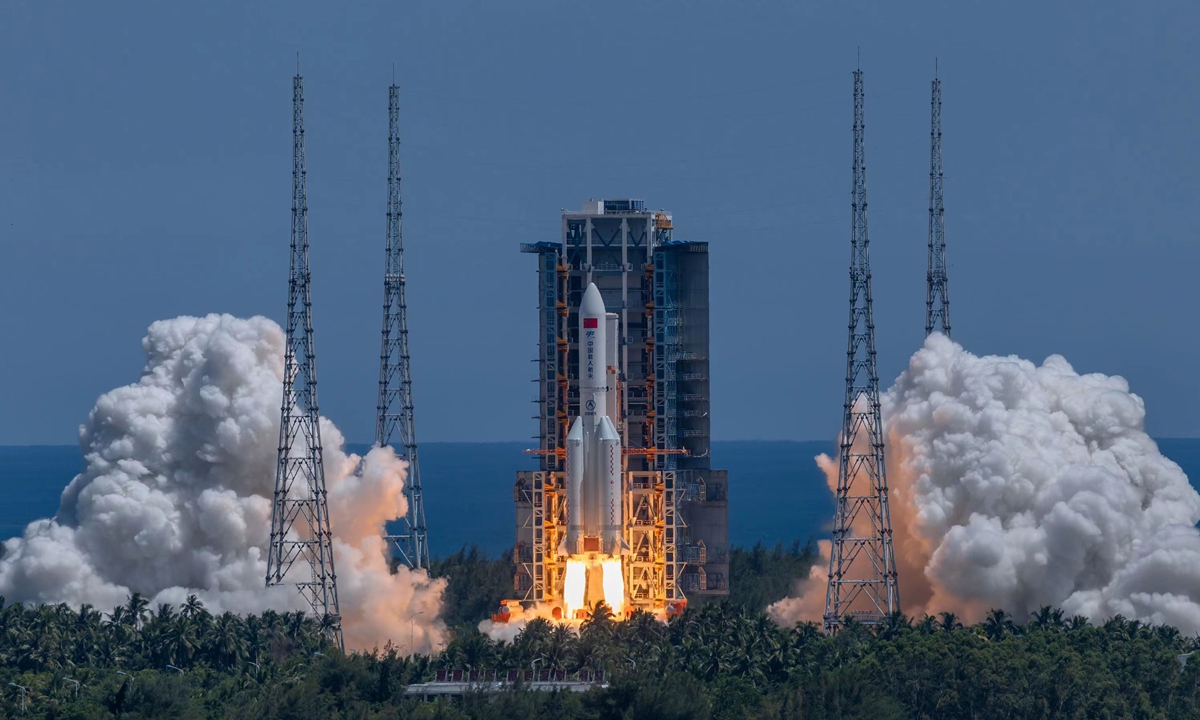
China launches Wentian lab module for space station. Photo: Fan Wei/GT
The China Manned Space Agency (CMSA) announced on Sunday that the Long March-5B Y3 carrier rocket reentered the Earth's atmosphere with the vast majority of the device burning up during re-entry, the fifth statement the agency has made reporting the debris' positions in the past week.
The announcement came amid US accusations against China over not sharing information on the trajectory of the rocket debris, which Chinese experts slammed as being groundless. They stressed that China has shown the most transparency to the international community by sharing predictions of the parameters of the trajectory of the rocket debris. The US has clearly known the facts and such smears come purely out of political purposes.
Debris from the upper stage of the Long March-5B Y3 carrier rocket reentered the atmosphere at 12:55 am on Sunday, with the vast majority of the device burning during re-entry, the CMSA said in a statement on Sunday. The remnants fell into the surrounding sea area at 119.0 degrees east longitude and 9.1 degrees north latitude, read the statement.
However, in a post on Twitter Sunday, NASA Administrator Bill Nelson accused China of not sharing "specific trajectory information" as the rocket fell back to Earth.
"All spacefaring nations should follow established best practices, and do their part to share this type of information in advance to allow reliable predictions of potential debris impact risk, especially for heavy-lift vehicles, like the Long March 5B, which carry a significant risk of loss of life and property," he wrote.
The facts are that the CMSA had already issued four statements reporting the parameters of the upper stage debris of the Long March 5B Yao-3 carrier rocket, covering information of its height of perigee, height of apogee and inclination at different time points every day from Wednesday to Saturday.
"How could the US say that they do not know where the debris would fall after China had made public the relevant parameters?" asked Song Zhongping, a TV commentator who closely follows China's space program.
"As the largest space power in the world, the US itself can accurately locate the falling point of the remnants given the high measurement and control technology of the country, coupled with the information China had already released. Therefore, its accusations against China are completely for the purpose of smearing and hype," Song told the Global Times.
Cooperation between China and the US in the field of space is illegal due to the two restrictive clauses that the US imposed on China, namely the Cox Report and the Wolf Amendment.
"It is against the law in the US for China to report space information to the country. Therefore China has no obligation to disclose any information directly to the US. China has always made its space information available to the international community. Why does the US turn a blind eye to it?" he said.
This is
not the first time that the US raised questions over the Long March-5B. The country made similar comments on May 2021 over the Long March-5B Y2 debris' re-entry when the rocket was commissioned to deliver the Tianhe core module.
However, it should be noted that up to now no casualty has been caused by the re-entry of Chinese rocket debris.
On the contrary, there have been many instances of large carrier rocket debris from the US having fallen into the sea and were not recovered. The country rarely issues warnings on the impact risk of Space X rocket debris, showing its double standards, Huang Zhicheng, a Chinese expert on aerospace science and technology, told the Global Times on Sunday.
Song also noted that debris from rockets launched by the US had landed in populated areas more than once.
The most recent was in July when a large piece of debris was found in the middle of a sheep paddock that could be linked to a large bang heard across the region earlier this month, ABC reported. Speculation was rife that it may have been caused by the SpaceX Dragon spacecraft re-entering earth's atmosphere after it launched in November 2020.
China has responsibly taken a variety of measures to deal with rocket debris by tracking its path and accurately predicting where it would fall. If the landing site is not a no-man's land, China will issue a warning in advance. China has a complete plan to ensure that nothing will go wrong, Song noted.




